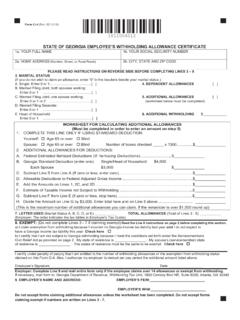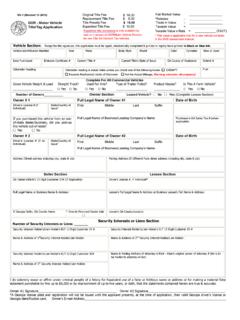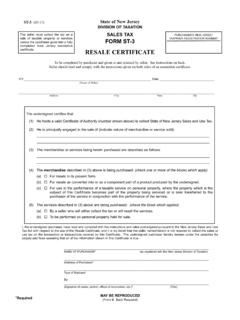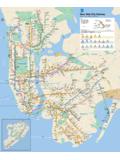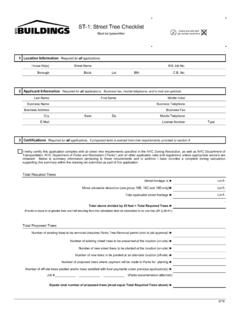Transcription of Sales and Use Tax Return (ST-3) Instructions
1 Sales and Use Tax Return (ST-3) Instructions **ATTENTION**. Effective date: This form ST-3 is effective for Sales beginning April 1, 2018. Important changes to form ST-3: Transportation local option taxes (TSPLOSTs) are no longer reported separately. TSPLOSTs are now reported in Part B on the same line with other local Sales and use taxes. The City of Atlanta no longer has a stand-alone jurisdiction code. Use 044A to report Sales sourced to DeKalb County inside the City of Atlanta. Use 060A to report Sales sourced to Fulton County inside the City of Atlanta. See Part B Instructions below for more information. TSPLOST-exempt Sales must now be reported separately. Add TE to the jurisdiction. For example, for TSPLOST-exempt Sales sourced to Fulton County outside the City of Atlanta, use 060TE; and use 060 ATE for TSPLOST-exempt Sales sourced to Fulton County inside the City of Atlanta. See Part B Instructions below for more information. Sales of tax-exempt food and food ingredients sourced to DeKalb County outside the City of Atlanta must be reported separately using code 044F.
2 See Part B Instructions below for more information. ( Sales of food and food ingredients sourced to DeKalb County inside the City of Atlanta are reported with non- food and food ingredients Sales using code 044A.) See Part B Instructions below for more information. Sourcing: Generally, Sales sourced to a jurisdiction include all Sales of property in which the property is delivered to the purchaser in the jurisdiction and Sales of services that are performed in the jurisdiction. Please refer to 48-8-77 for specific sourcing rules. Electronic filing: To file and pay electronically, please visit the Georgia Tax Center at Additional information, instructional videos, and frequently asked questions about electronic filing can be found at General Instructions : Record the Sales and Use Tax Number (STN), name, and address of the registered taxpayer. The Period Ending should be the end date (mm/dd/yy) of the reporting period. Check the Amended Return box if you are amending a previously filed Return for the same period.
3 Check the No Tax Due box if there were no taxable Sales during this period. If there has been no Sales and use tax activity during the period, do not complete this form . Please check the No Sales /Use Tax Activity box on Page 4, and complete and submit the payment voucher ( form PV-ST Sales and Use Tax Voucher) only. Part A - Tax Summary LINE. 1 Record total state Sales (all Sales sourced to the State of Georgia), including leases and rentals. 2 Record total exempt state Sales , including leases and rentals. Include all Sales that are exempt from state Sales tax, even if such Sales are subject to local Sales tax. 3 Subtract exempt state Sales (Line 2) from total state Sales (Line 1) and record taxable Page 2. state Sales . 4 Complete Part B, and record the total Sales tax from Part B, Line 21. 5 Record the total use tax from Part B, Line 26. 6 Record the pre-paid local Sales /use tax for on-road motor fuel (from form ST-3 Motor Fuel), if applicable. 7 Record total Sales /use tax collected for reporting period from taxpayer accounting records.
4 8 Add Line 4 + Line 5 + Line 6. 9 Subtract Line 8 from Line 7 to calculate excess tax collected. Include excess tax collected in the appropriate Sales /use category for vendor's compensation in Part C. 10 Complete Part C, and record the total vendor's compensation from Part C, Line 5. 11 Record previous prepaid estimated tax, if applicable. Please reference your annual prepaid estimated tax letter. 12 Record current prepaid estimated tax, if applicable. Please reference your annual prepaid estimated tax letter. 13 Add Lines 8 and 9, subtract Lines 10 and 11, and add Line 12 for the total amount due. Part B - Sales Tax Distribution Table LINE. 1 Record the taxable state Sales (total Sales sourced to the State of Georgia LESS. Sales of energy to manufacturers and all other state tax exempt Sales ). Multiply this amount by the rate indicated and record the Sales tax amount for the state. 2 Record taxable Sales sourced to DeKalb County inside the City of Atlanta. Do not include Sales that are exempt from one or more local taxes.
5 For example, do not include TSPLOST-exempt Sales . Multiply taxable Sales by the indicated rate, and record the amount in the Sales tax amount column. 3 Record TSPLOST-exempt Sales sourced to DeKalb County inside the City of Atlanta. Generally, TSPLOST-exempt Sales include Sales of fuel used for off-road heavy-duty equipment, off-road farm or agricultural equipment, or locomotives; and motor fuel as defined in 48-9-2(9) for public mass transit. Multiply the Sales by the indicated rate, and record the amount in the Sales tax amount column. 4 Record taxable Sales sourced to DeKalb County outside the City of Atlanta that are not Sales of tax-exempt food and food ingredients . Do not include Sales that are exempt from one or more local tax. Multiply the taxable Sales by the indicated rate, and record the amount in the Sales tax amount column. 5 Record Sales of tax-exempt food and food ingredients that are sourced to DeKalb County outside the City of Atlanta. Multiply the Sales by the indicated rate, and record the amount in the Sales tax amount column.
6 6 Record taxable Sales sourced to Fulton County inside the City of Atlanta. Do not include Sales that are exempt from one or more local taxes. For example, do not include TSPLOST-exempt Sales . Multiply taxable Sales by the indicated rate, and record the amount in the Sales tax amount column. 7 Record TSPLOST-exempt Sales sourced to Fulton County inside the City of Atlanta. Generally, TSPLOST-exempt Sales include sale of fuel used for off-road heavy-duty equipment, off-road farm or agricultural equipment, or locomotives; and motor fuel as Page 3. defined in 48-9-2(9) for public mass transit. Multiply the Sales by the indicated rate, and record the amount in the Sales tax amount column. 8-19 Use Lines 8-19 and addendum pages to record taxable Sales sourced to other jurisdictions. List the county name, code (see rate charts), and dollar amount of taxable Sales . Multiply the amount of taxable Sales by the rate, and record the amount in the Sales tax amount column. Note 1: Sales of energy to manufacturers must be recorded by jurisdiction on a separate line.
7 Use the jurisdiction code followed by "E" ( , 060E). The rate chart for energy sold to manufacturers is located at Note 2: TSPLOST-exempt Sales must be recorded by jurisdiction on a separate line. Use the jurisdiction code followed by "TE" ( , 060TE). The rate chart for TSPLOST-exempt Sales is located at current-historical-and-upcoming. 20 If you recorded Sales on addendum(s), enter the total Sales tax amount from the addendum(s). Additional addendum pages ( form ST-3 Addendum Sales ) are located at 21 Record the sum of Lines 1-20 as total Sales tax and record this amount on Part A, Line 4. Part B Use Tax Distribution Table LINE. 22-24 Use Lines 22-24 and addendum(s) to record state and local use tax by jurisdiction of use. For each entry, record the jurisdiction, and reason code. Use tax is due if applicable Georgia Sales tax was not paid on an item purchased or leased and that item has been placed into use within Georgia. Jurisdiction of use means the jurisdiction in which the product was first used in Georgia.
8 The use tax reason codes are: Code Reason 01 Georgia use item purchased tax-paid in Georgia and used in another jurisdiction having a higher local tax rate. 02 Withdrawal from inventory in Georgia. 03 Import-use (state tax only). The jurisdiction State (000) must be used for this code. 04 Import-use (local tax only). Examples of taxable transactions and reason codes include: A contractor purchases an item for $ in a Georgia jurisdiction where the total Sales tax rate is 6% and uses the item to fulfill a contract in a jurisdiction where the total Sales tax rate is 8%. The contractor owes additional use tax of 2% and should record local use tax due of $ ($ x .02). The use tax reason code is 01. A Georgia furniture manufacturer withdraws a table worth $ from inventory to Page 4. use in the business's break room. The manufacturer owes state and local use tax based on the fair market value of the table at the rate in effect in the jurisdiction where the withdrawal from inventory occurs.
9 The manufacturer should calculate the use tax due by multiplying the combined state and local use tax rate by $ and recording the resulting use tax. The use tax reason code is 02. A Georgia resident or Georgia business purchases an item for $ , and the seller does not charge Sales tax. The purchaser owes use tax based on the rate in effect in the jurisdiction where the purchaser receives the item. The purchaser should calculate state use tax by multiplying the applicable state use tax of 4% by $ and recording the resulting state use tax due with the use tax reason code 03. The purchaser should calculate the local use tax due by multiplying the applicable local use tax rate by $ and recording the resulting local use tax due with the use tax reason code 04. A Georgia resident or Georgia business purchases a $ item outside of Georgia, pays the other state's 5% state Sales tax at the time of purchase and returns to Georgia with the item. The purchaser will receive credit against Georgia's 4% state use tax due and thus owes no additional state use tax.
10 The purchaser owes local use tax at the rate in effect in the jurisdiction where the purchaser lives or where the business is located. The purchaser should calculate the local use tax due by multiplying the applicable local use tax rate by $ and recording the resulting local use tax due. The use tax reason code is 04. 25 If you recorded uses on addendum(s), enter the total use tax amount from the addendum(s). Additional addendum pages ( form ST-3 Addendum Use) are located at 26 Record the sum of Lines 22-25 as total use tax, and record this amount on Part A, Line 5. Part C Vendor's Compensation Calculation LINE. 1 Calculate the total state and local Sales and use tax on non-motor fuel Sales by adding Lines 4, 5, and 9 of Part A and subtracting Sales and use tax on off-road motor fuel, if applicable. Record the first $3000 of state and local Sales and use tax on non-motor fuel Sales in the "Tax Amounts" column. Multiply the amount in the "Tax Amounts" column by the rate.


